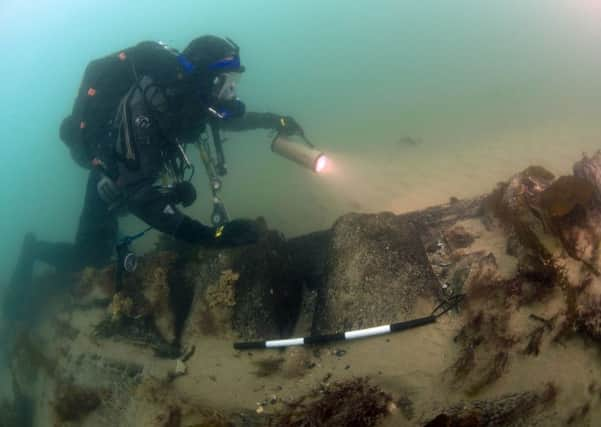Joy as £2m fund presented to save iconic Invincible from Solent seabed


Former chancellor George Osborne has announced more than £2m will be spent on excavating HMS Invincible, which sank in 1758, in a project involving veterans, serving personnel and disadvantaged teenagers.
The ship – the first to bear the name – lies on Horse Tail Sands in the eastern Solent, close to Portsmouth.
Advertisement
Hide AdAdvertisement
Hide AdIt comes amid concerns over the future of the iconic warship, which was named as one of the UK’s most at-risk maritime heritage sites three years ago.
The hope is that the latest cash injection from the Libor rate fixing scandal penalties pot will be able to save Invincible from rotting on the Solent seabed.
Alison James, Historic England maritime archaeologist, said the cash would prove vital in preserving the historic warship for future generations.
She said: ‘We are delighted that money has been allocated to support engagement with our maritime past and to ensure that the remains of HMS Invincible are safeguarded for future generations.
Advertisement
Hide AdAdvertisement
Hide Ad‘This significant funding boost will make a real difference as we work with Maritime Archaeology Sea Trust and the licensee to preserve and interpret the Invincible with a view to the wreck coming off the “at risk” register in the future.’
Invincible was captured by the British at the first Battle of Finisterre in 1747 and taken into the Royal Navy.
In 1758 the 74-gun vessel ran aground at Horse Tail Sands while on her way to Canada and was only rediscovered in 1979 by a local fisherman. But Invincible was placed on the at-risk register in 2013 after parts of the ship became exposed.
Portsmouth South MP Flick Drummond said the cash would be crucial in preserving a key piece of Britain’s naval history and says that Portsmouth is the perfect city to tackle such a task.
Advertisement
Hide AdAdvertisement
Hide Ad‘This award to excavate the wreck of Invincible is timely as the structure is under risk, so I thank Mr Osborne for making it happen,’ she said.
‘I know there have been some concerns about conserving the ship and securing artefacts against damage and theft.
‘Luckily, we have enormous expertise in this area around Portsmouth from the Mary Rose project, who I’m sure will pass on their knowledge to the veterans and young people taking part in the project.
‘It’s super they will learn new skills,and help us learn a lot more about our past. I hope too the French, who built the ship before it was captured by the Royal Navy, will be interested in the project.’
Advertisement
Hide AdAdvertisement
Hide AdLast year the ex-chancellor handed £600,000 to Southsea’s D-Day Museum and a further £2m from the Libor pot was invested into the Royal Marines Museum move to the Historic Dockyard.
Speaking of the latest heritage fund boost, city council leader Donna Jones said: ‘This is absolutely fantastic news.
‘It shows the government is reaffirming their understanding of the significant importance of the maritime heritage of this country and the part Portsmouth has played in this.’
A similar excavation project was launched to rescue the remains of Henry VIII’s flagship, Mary Rose.
Advertisement
Hide AdAdvertisement
Hide AdThe Tudor ship sank in sank in 1545 and was rediscovered more than 200 years later, in 1971. In 1982 the world watched as the Mary Rose was lifted from the depths, beginning a 34-year journey to preserve her.
She is now in the final stages of a conservation project at the Mary Rose Museum, which re-opens on Wednesday with improved viewing of the ship.